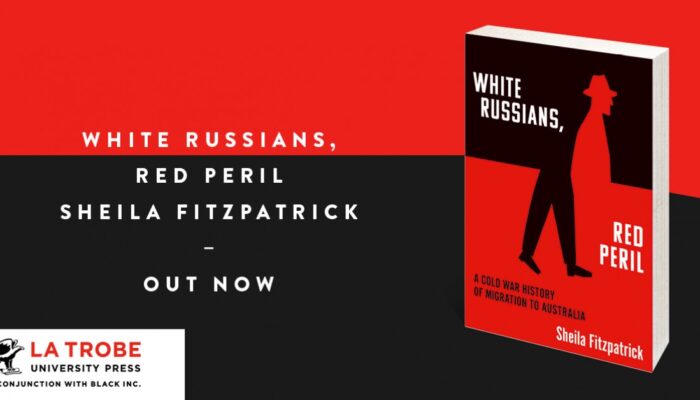Book Review: ‘White Russians, Red Peril: A Cold War History of Migration to Australia – Sheila Fitzpatrick
Sheila Fitzpatrick, from a famous family of Australian historians, is an internationally-recognised expert on Stalinist Russia, but her interest in Russian emigration came through researching her late husband, Michael, the Latvian-born son of a displaced Hungarian father. The pre-WW2 decades showed a fairly stable presence in Australia of around 5,000 Russians including about 400-500 Tsarist exiles; the latter were leftwing activists from pre-revolution Russia who were watched intrusively by Australian governments, provoking Brisbane’s ‘Red Flag riots’ of 1919. Russian Jews were persecuted in pre-Bolshevik times, and some identified with the Left, such as the author Judah Waten, and painter Danila Vassilieff, but most interwar émigrés identified with anti-communism and by implication anti-Laborism. Yet the rise of fascism and the significance of the Soviet state during the period led to a wide range of political views.
After WW2, Russians were not high up in the preference hierarchy for Arthur Calwell, Chifley’s Immigration Minister and famous for his priority towards ‘beautiful Balts’, former Soviet citizens but Nordic not Slavic. They were only a small part of the post-WW2 immigration wave in Australia, and came from two directions: the European DP (displaced persons) camps, but also from China (the White Russians). The latter group had left Russia after the post-revolution civil war in the early 1920s, many settling in the cosmopolitan milieux of Paris, Berlin and Harbin (Manchuria), as well as China’s coastal cities of Shanghai and Tianjin, until the Maoist victory in 1949 made them uncomfortable within the new Communist state. For conservatives, the Russian Orthodox church acted internationally as a unifier for émigrés, and the Boy Scout movement was a site to develop physical skills and preserve a Russian identity – this continued for those who came to Australia, setting up alumni organisations too.
After WW2 the DPs were seen as a valuable economic resource both to Soviet Russia, which asserted their prior allegiance, and the New World states seeking worker immigrants, with their “chosen freedom” to live outside a communist state being a useful argument. Politics influenced the overarching role of the international refugee agencies, firstly UNRRA (United Nations Relief and Rehabilitation Agency) with its repatriation mission, then its 1947 replacement IRO (International Refugee Organisation0, with a resettlement orientation outside Europe, and a shift towards defining the DPs as victims of communism. This ‘liberalisation’ was important in allowing more White Russians to move to Australia. Despite their anti-communism, those who were Soviet émigrés from China to Australia often brought with them some socialist values around equity and welfare support, and pride in the Soviet Union’s achievements in the war, attracting surveillance from Australian security police. The Cold War looms large here with stories of ASIO, Russian spies and Nazi war criminals.
Of interest to students of migration is the framework adopted to select DP candidates, which was different to other countries, and the strongly directed government role post-arrival. Australia had more detailed specifications of its migrant needs than other countries. Calwell stipulated ‘horny handed toilers’: only prize physical specimens passed the medical examination, and no professionals, traders, retailers or intellectuals were allowed. Yet it was found that many of the farmers and labourers on the first shipment spoke English, with nice manners and soft hands. Also different was that the Australian program was a state-sponsored scheme, not reliant on community sponsorship, with housing provided in camps and hostels, and two years’ compulsory manual work in assigned jobs. This indentured labour was unpopular in the DP camps, was criticised by the Soviet Union as stealing their citizens for ‘slave labour’, and criticised by some Australian unions. An important research question for today is about the prominent role of private sponsorship of refugees in Canada in contrast to Australia. Does it partly explain why Canada has socially embedded a stronger and successful advocacy for relatively larger intakes from more recent conflicts in Vietnam, Syria, and Afghanistan?
The IRO tried hard to undermine Australia’s anti-Jewish preferences (Brazil and Canada were the same), but the gap between Australia’s claim of non-discrimination and reality continued. Governments like control but humans find ways around it. Fitzpatrick estimates about 10-12 percent of the DPs who arrived were Jewish, about half of their proportion in European camps.
There is not much uniformity – of belief, ethnicity, politics, formative experience, allegiance – amongst the ‘generic Russians’, and the author has gone to great lengths in trawling the source material to avoid over-generalisation. The refugees were acutely aware of the possible adverse consequences from how they might be perceived: not just by identity but as traitors, collaborators, deserters, victims. She is well aware of the ambiguities, deceptions and complicated lives of her book’s interviewees and Russian émigrés generally. It all leads to a complex mosaic, information-rich and forensically informed by archives such as the National Library of Australia’s (treasure) Trove, and many other primary sources.
Kevin Bain’s refugee reading guide is at https://baysiderefugeesupport.
